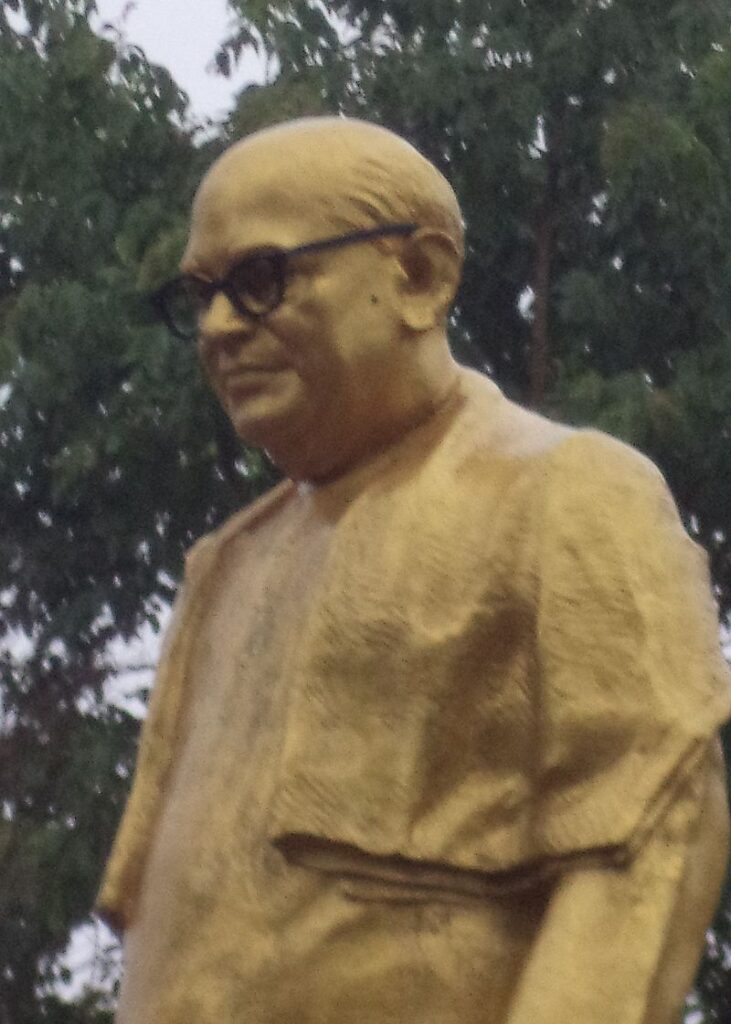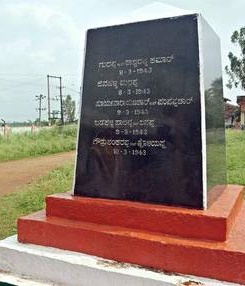
The Indian Independence Movement, as all of us are aware, was a series of historic events whose ultimate aim was to end British rule in India and secure freedom for the country. The freedom struggle initiated by leaders like Naoroji, Gokhale, Ranade, Tilak and others, spanned over a period of ninety years from 1857 to 1947. The freedom that we are enjoying today is the result of struggle and sacrifices of thousands of our countrymen.
Whenever we talk or write about Indian Freedom Struggle, we mention only national level movements like Salt Satyagraha (Dandi March), Quit India Movement and others which are well documented and very much in public memory. We should understand that not only national level movements strengthened India’s struggle for freedom but many regional level movements also played significant role in shaping our country’s freedom struggle. But unfortunately, they have faded away from public memory. In this article, I am trying to narrate some of the forgotten incidents of Indian Freedom Struggle in Karnataka. It is befitting to reminisce these events in the year of Azadi Ka Amrit Mahotsav.
This movement took place at Turuvanuru, a remote village in Chitradurga district of Karnataka. With this movement, the village became a centre of activities during the freedom struggle.
In 1939, Mahatma Gandhi gave a call for prohibition of liquor in the country. In response to Gandhi’s call, a group of about 70 to 80 villagers which included women resorted to cutting toddy trees in and around Turuvanuru village.

True Gandhian Late S. Nijalingappa led this movement. He was arrested and imprisoned for about one and a half year. Later on, he became the Chief Minister of Karnataka. The movement which lasted for several months caught the attention of Mahatma Gandhi. His personal secretary Mahadeva Desai, visited the village in 1942, appreciated the stand taken by the villagers and extended support to the agitation.
The act of felling toddy trees resulted in stoppage of arrack production (Arrack is extracted from these trees) and caused huge revenue loss to the government. The Mysore king imposed Pundu Kandaya on the village but the villagers refused to pay tax and became a significant part of the “no tax campaign “. Though this movement was of a smaller magnitude, it resulted in consolidation of people’s voice against the British rule and strengthened people’s resolve to drive away the British from our country. A bronze statue of Mahatma Gandhi was installed in the village in 1948 as a mark of respect to the memory of the Father of Nation.

Mahatma Gandhi’s historic Dandi March which took place between 12th March and 6th April 1930, inspired many freedom fighters all over the country. It may not be out of place if I mention here that Sri Mailara Mahadevappa from Haveri district was the lone representative from Karnataka who accompanied Gandhi on the Dandi March. Congress leaders in Karnataka also decided to stage Satyagraha in Karnataka.
A meeting was held at Dharwad to select a place for staging Salt Satyagraha. A committee consisting of R.R.Diwakar, i Karnad Sadashiva Rao and Sri.Hanumantha Rao Koujalagi was constituted to select a place for “Uppina Satyagraha”. The committee selected Ankola, a town located on the Arabian coast in Uttara Kannada district. On April 13, 1930 about 40,000 people under the leadership of Sri M.P.Nadkarni gathered at Poojigeri, a place near Ankola and broke the salt rule by making salt. Several leaders which included N.S.Hardikar, Govinda Nayaka and others participated in the agitation. The villagers brought salt from the sea shore in earthen pots and sold in the town without paying any kind of tax to the British government. It is documented that the Satyagraha went on for six weeks despite the arrest of the leaders by the British police.

The British rule in India had banned hoisting of tricolour flag (saffron, white and green with spinning wheel at the centre) in the country. As a mark of defiance against the British imposed restrictions on civil freedom, hoisting of tricolour flag was a common occurrence and witnessed enthusiastic participation from people all over the country. The Flag Satyagraha occurred in Nagpur and Jabalpur in 1923. Apart from these incidents, notable Flag Satyagrahas were organised in our state of Karnataka in 1938, one at Shivapura and the other at Viduraswatha.
The first conference of Mysuru Congress (Earlier Karnataka was known as Mysore State) was held in 1938 at Shivapura, near Maddur in Mandya district. It was resolved in the conference to organise Flag Satyagraha and hoist tricolor flag in the farm land belonging to Thirumale Gowda. The then Deputy Commissioner of the district warned the people against hoisting of tricolour flag. Instead, the Deputy Commissioner suggested to hoist Gandaberunda Flag, the royal emblem of Wadiyar dynasty. Mysuru Congress President T Siddalingaiah was to hoist the flag on April 9th, 1938. About ten thousand people including women assembled at the farm land belonging to Thirumale Gowda.
The flag post which was actually a 60 foot tall arecanut tree was well guarded by women members. When T.Siddalingaiah was about to hoist the flag, the police arrested him. M.N Jois, another leader who was there by the side of Siddalingaiah pulled the string and hoisted the flag. Thus the objective of the event was accomplished right under the nose of the British police. The police arrested all the leaders who participated in the agitation. The flag hoisting ceremony lasted for several days and large number of people travelled to Shivapura to see the flag.
The incident is known as Shivapura Dwaja Satyagraha. Satyagraha Soudha was constructed to commemorate the Shivapura Dwaja Satyagraha of 1938 with the initiative undertaken by Kengal Hanumanthaiah, Former Chief Minister of Karnataka. The Soudha was declared open on 26th September 1979. It is located adjacent to the Bengaluru – Mysuru highway and the magnificent monument can be seen by everyone travelling on the highway. But it is reported that the Soudha is poorly maintained and has lost the glory due to government’s apathy.

Esuru is a hamlet in Shikaripura taluk of Shivamogga district of Karnataka. It is located at about 50km from the district headquarters. Though Esuru is a non-descript village, it has created indelible mark in the annals of the freedom struggle. In 1942, the year of Quit India Movement, Esuru village created history in the country. It is the first village in Karnataka to self-declare independence and having a parallel government.
In 1942, the residents of the village refused to pay land revenue as the agriculturists of the village suffered huge loss due to natural calamity. The villagers vehemently resisted the intimidatory strategies of the British and fought against the British police with courage and determination. The revolutionaries assembled at Veerabhadreswara Temple to discuss about the strategies for their struggle. The villagers had completely barred the British officials from entering the village. All the roads leading to Esuru village were fenced. They hoisted the tricolour flag on the top of the Veerabhadreswara shrine on September 29th, 1942 and boldly declared the village “Free from the British Raj” by putting up a board which read “Swaraj Sarakara”. When British officials tried to enter the village, villagers strongly opposed their entry which led to riot that resulted in the killing of two revenue officials and injuring many villagers. In order to reclaim the village, police troops were sent to the village by British government. The rebellion had serious consequences on the Esuru village. Hundreds of villagers were imprisoned and five youth were hanged. The Britishers wanted to crush the rebellion completely thereby teach villagers a lesson. When the villagers came to know about the impending attack on them by the British, they hid in a nearby forest leaving behind women, children and aged people in the village. As empty streets greeted the British force, they became furious and unleashed violence on women, children and elders. After the independence, all the freedom fighters were released and they were given a grand reception by the people of Shivamogga district. A memorial for freedom fighters has been built at Esuru village. The memorial is in ruins again due to government’s apathy.
As narrated, there are several such incidents in which commoners participated with intense patriotic fervour and many sacrificed their lives. On the occasion of Azadi ka Amrit Mahostav, we shall all pay sincere tributes to the memory of thousands of country men, unsung heroes, who sacrificed their lives for the sake of the nation.






The article envisages a trail of incidents which though not much narrated in the saga of freedom struggle are noteworthy. As a true patriot instilling thr spirit of freedom struggle among young generation is the need of the hour.
I congratulate and appreciate Dr Srikanta my Principal for his commitment and dedication towards reviving the glory of unsung heroes in our pages of history.
Thank you sir…it iis indeed a reminiscent of our struggle for independence.
Contribution to freedom movement by localites can’t be ignored. These are not included in the History syllabus and not taught to the younger generation of students. Dr.B.S. Srikanta Sir has aroused the importance of these local freedom movements. Many more such incidents have to be explored and made known to everyone.
The article motivates the present generation to really know, how our freedom fighters struggled to get freedom of our nation.
I would like congratulate our Principal Dr. Srikanta B S for the great work.
It manifests your patriotism towards our nation sir. The passion in this beautiful work which doesn’t ignore the minutiae is just fabulous.
It manifests your patriotism towards our nation sir. The passion in this beautiful work which does not ignore the minutiae is just fabulous.
Very interesting to know the contribution of common man in India freedom struggle. These historic moments will inspire us to contribute for the pride of our nation.
Sir, Excellent information and good article.thak you sir.
less noticeable incidents that added fuel to the fire of independence movement deserves to be remembered on this special occasion of Azadì ka Amruth Mahotsav. The unsung heroes of this period gave a vehement blow to British empire to withdraw from colonised country like India. Other colonised countries would have drawn inspiration from such incidents seeking liberties. Dr. B. S. Srikanta sir as a true Gandhian has fulfilled this requirement through this article.
Thank you Dr. B S Srikanta Sir for sharing, To be honest I was not knowing many of these local freedom movements. We are really proud of unsung Hero’s.
Thank you
Shashi Mishra
बहुत ही ज्ञानवर्धक लेख है। इससे हमें कर्नाटक राज्य के स्वतंत्रता सेनानियों के विषय मे पर्याप्त जानकारी प्राप्त हुई है। आपका बहुत बहुत धन्यवाद।
लेख बहुत ही ज्ञान वर्धक है। इससे हमें कर्नाटक राज्य के स्वतंत्रता सेनानियों के विषय मे पर्याप्त जानकारी मिली है। बहुत बहुत धन्यवाद सर।
Hare Krishna!
wonderful information Sir ..about many of our unsung heroes …our system especially in education have glorified few patriots and have mentioned only about them till date.
Hope things change and our students get to read all this at least in forth coming days .
Excellent